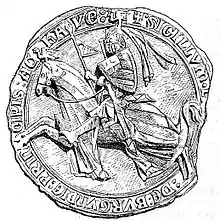Louis of Burgundy
Louis of Burgundy (1297 – August 2, 1316) was a member of the Capetian House of Burgundy who ruled the Principality of Achaea and claimed the defunct Kingdom of Thessalonica.
| Louis | |
|---|---|
| titular king of Thessalonica | |
 Seal of Louis | |
| Prince of Achaea | |
| Reign | 1313 - 1316 |
| Predecessor | Philip I of Taranto |
| Successor | Matilda of Hainaut |
| Born | 1297 |
| Died | 2 August 1316 |
| Spouse | Matilda of Hainaut |
| House | Burgundy |
| Father | Robert II, Duke of Burgundy |
| Mother | Agnes of France |
Louis was a younger son of Duke Robert II of Burgundy and Agnes of France. In 1313, he took part in a complex marriage pact designed to secure control by the Angevins and the Burgundians over Frankish Greece. On July 31, 1313, he married Matilda of Hainaut, heir-general of William II Villehardouin, to whom Philip I of Taranto gave the Principality of Achaea in fief. Louis ceded his claims on the family lands in Burgundy to his elder brother, Duke Hugh V of Burgundy, who in turn ceded to Louis the claim to the Kingdom of Thessalonica, which had been sold to their family in 1266. He subsequently did homage to Philip of Taranto, who was suzerain of Achaea and nominally also Thessalonica as titular Latin emperor, and agreed to assist in a campaign to recapture the Latin Empire.
Matilda and Louis arrived separately in Achaea, she sailing directly from Marseille to Navarino with 1,000 troops, while Louis came by way of Venice, where he was soliciting aid from the Republic. Ferdinand of Majorca, who also claimed the principality jure uxoris (his wife Isabelle de Sabran was descended from the younger daughter of William II Villehardouin), had landed there in 1315 and taken to Glarentza. Matilda arrived late in 1315, and several barons, including the count of Cephalonia returned to her allegiance. However, her army was beaten by Ferdinand and his Catalans on February 22, 1316 at Picotin. About this time, Louis arrived, making an unsuccessful attempt to capture the castle of Chalandritsa. Ferdinand sent for aid from the Kingdom of Majorca and the Catalan Company, but neither arrived in time to prevent his death and defeat by Louis at the Battle of Manolada on July 5, 1316. Four weeks later, Louis died. The Chronicle of the Morea attributes his death to a fever, while the Catalan Declaratio summa states that he was poisoned by Count John I Orsini of Cephalonia. His death left Achaea in an unsettled state, with his brother Odo, his widow, and the Angevins all attempting to gain it.
References
- Bon, Antoine (1969). La Morée franque. Recherches historiques, topographiques et archéologiques sur la principauté d'Achaïe [The Frankish Morea. Historical, Topographic and Archaeological Studies on the Principality of Achaea] (in French). Paris: De Boccard. OCLC 869621129.
- Topping, Peter (1975). "The Morea, 1311–1364". In Setton, Kenneth M.; Hazard, Harry W. (eds.). A History of the Crusades, Volume III: The Fourteenth and Fifteenth Centuries. Madison and London: University of Wisconsin Press. pp. 104–140. ISBN 0-299-06670-3.
| Regnal titles | ||
|---|---|---|
| Preceded by Philip |
Prince of Achaea with Matilda 1313–1316 |
Succeeded by Matilda |